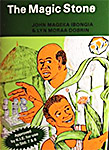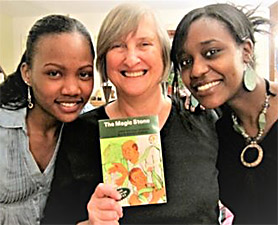“THE MAGIC STONE and the Woman who Wrote It!” (Kenya)
While Arthur Dobrin was a student at City College in New York, he heard Harris Wofford speak at the college, and afterwards he went to Lyn and said, “Let’s join the Peace Corps.” In August of 1964, shortly before they were married, Lyn and Arthur Dobrin, applied to the Peace Corps.
They were first offered Volunteer placement inThailand. “We didn’t want to do it because the assignment involved moving all over the country. We wanted to stay in one place and Arthur was more interested in Africa so when we were offered a project in cooperative development in Kenya, we said yes.”
In addition to her assigned role of working with farmers cooperatives, Lyn had two additional goals. She wanted to write a cookbook and collect folk tales. She had decided before leaving for Kenya that she wanted to “write something that Kenyan children could relate to.”
 The cookbook never happened, but her book, The Magic Stone, was published in 1968. It has been in print ever since. It is used in all the elementary schools in Kenya.
The cookbook never happened, but her book, The Magic Stone, was published in 1968. It has been in print ever since. It is used in all the elementary schools in Kenya.
Lyn wanted to write locally based stories because the books the children had in their classes in Kenya were left over from British colonialism. That was also, said Lyn, the goal of John Nottingham, the publisher at East African Publishing House in Nairobi. Lyn had come to know Nottingham because her husband, Arthur, had anonymously written an expose of cooperative projects that Nottingham published in his East Africa Journal.
Lyn and Nottingham then became friends with a young Kenyan named John Ibongia who said he had children’s tales of the Kisii people, the ethnic group Lyn and Arthur were living with. John told Lyn the stories, and she rewrote them into a more tell-able form, sent them to Nottingham and he published the stories under the title The Magic Stone
The imprint of The Magic Stone was taken over by Phoenix Press many years later, and was used in the elementary schools of Kenya and Tanzania.
Lyn did not take her share of the royalties out of Kenya. Her payments have been used to pay for the education of several children, and to build a house for a Kisii couple, close friends of Lyn and Arthur since the 1960s.
While in the Peace Corps in Kenya, Lyn gave birth to her son Eric in 1966; her daughter Kori was born two years later in the U.S.
In 1976 the Dobrins returned to Kenya with their two young children and lived in a house friends found for them on a Catholic church/school compound. Their two young children attended school while the family lived in-country for five months.
At that time they found out about a reforestation program underway near where they had lived as Volunteers, and when they returned to the U.S. they started a program “Trees for East Africa” at the Ethical Humanist Society of Long Island, to raise money to pay the salary of a tractor driver who was responsible for planting the trees.
In the 1980s they next started leading trips for Kenya for American social workers through the Adelphi School of Social Work. They met with their Kenyan counterparts, visited social welfare projects, went on wildlife safaris and were feted by friends in Kisii.
At that time, another friend, Dr. Japhet Maranga, told them that he and his wife Helen were building an elementary school near Kisii Town and Lyn and Arthur created “The Kenya Fund,” also at the Ethical Humanist Society, to raise money for the school.
The only sad note Lyn has takes away from her Peace Corps years happened twenty-five years after her children’s book was published in Kenya.
She received a letter from John Ibongia, her co-author, with whom she had not kept in touch. He wrote and told her that he had finally forgiven her. He told her then that he had expected Lyn and Arthur to take him to America when they left in 1967.
“That was never in my mind but he had made that assumption. I felt terrible about how he had suffered.”
That was, however, not how her story of Africa ends.
 A few years ago two Kenyan women studying at Hofstra University on Long Island, New York, where Arthur teaches, came to the Dobrin home for dinner. “When I showed them a copy of The Magic Stone they were all excited about seeing it. They both had read The Magic Stone when they were children in elementary school. The two women had come from different parts of Kenya so it confirmed for me that the book was being distributed throughout the country. It felt wonderful to know that after all these years.”
A few years ago two Kenyan women studying at Hofstra University on Long Island, New York, where Arthur teaches, came to the Dobrin home for dinner. “When I showed them a copy of The Magic Stone they were all excited about seeing it. They both had read The Magic Stone when they were children in elementary school. The two women had come from different parts of Kenya so it confirmed for me that the book was being distributed throughout the country. It felt wonderful to know that after all these years.”
•
The Magic Stone
John Ibongia and Lyn Dobrin (Kenya 1965–67)
Ad Infinitum Books
$5.00 (paper)
May sir John ibonhia ‘s soul be at peace
A good story book for schools